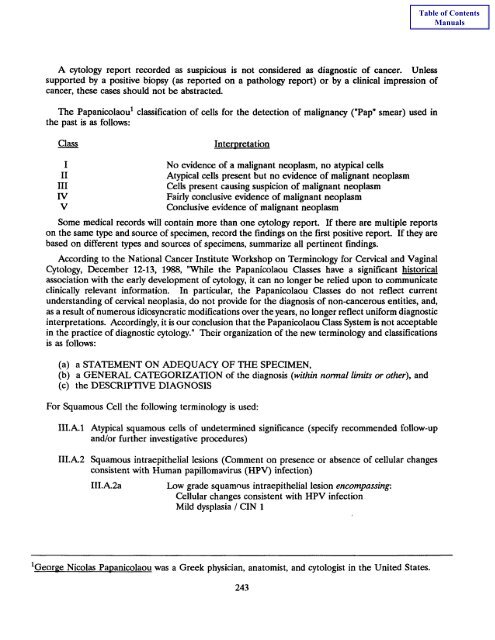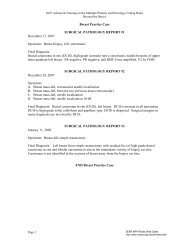Self Instructional Manual for Cancer Registrars - SEER - National ...
Self Instructional Manual for Cancer Registrars - SEER - National ...
Self Instructional Manual for Cancer Registrars - SEER - National ...
Create successful ePaper yourself
Turn your PDF publications into a flip-book with our unique Google optimized e-Paper software.
A cytology report recorded as suspicious is not considered as diagnostic of cancer. Unless<br />
supported by a positive biopsy (as reported on a pathology report) or by a clinical impression of<br />
cancer, these cases should not be abstracted.<br />
The Papanicolaou 1 classification of cells <strong>for</strong> the detection<br />
the past is as follows:<br />
of malignancy ("Pap_ smear) used in<br />
Class<br />
Interpretation<br />
I<br />
II<br />
III<br />
IV<br />
V<br />
No evidence of a malignant neoplasm, no atypical cells<br />
Atypical cells present but no evidence of malignant neoplasm<br />
Cells present causing suspicion of malignant neoplasm<br />
Fairly conclusive evidence of malignant neoplasm<br />
Conclusive evidence of malignant neoplasm<br />
Some medical records will contain more than one cytology report. If there are multiple reports<br />
on the same type and source of specimen, record the findings on the first positive report. If they are<br />
based on different types and sources of specimens, summarize all pertinent findings.<br />
According to the <strong>National</strong> <strong>Cancer</strong> Institute Workshop on Terminology <strong>for</strong> Cervical and Vaginal<br />
Cytology, December 12-13, 1988, "While the Papanicolaou Classes have a significant historical<br />
association with the early development of cytology, it can no longer be relied upon to communicate<br />
clinically relevant in<strong>for</strong>mation. In particular, the Papanicolaou Classes do not reflect current<br />
understanding of cervical neoplasia, do not provide <strong>for</strong> the diagnosis of non-cancerous entities, and,<br />
as a result of numerous idiosyncratic modifications over the years, no longer reflect uni<strong>for</strong>m diagnostic<br />
interpretations. Accordingly, it is our conclusion that the Papanicolaou Class System is not acceptable<br />
in the practice of diagnostic cytology." Their organization of the new terminology and classifications<br />
is as follows:<br />
(a) a STATEMENT ON ADEQUACY OF THE SPECIMEN,<br />
(b) a GENERAL CATEGORIZATION of the diagnosis (within normal limits or other), and<br />
(c) the DESCRIPTIVE DIAGNOSIS<br />
For Squamous Cell the following terminology is used:<br />
III.A.1 Atypical squamous cells of undetermined significance (specify recommended follow-up<br />
and/or further investigative procedures)<br />
III.A.2 Squamous intraepithelial lesions (Comment on presence or absence of cellular changes<br />
consistent with Human papillomavirus (HPV) infection)<br />
III.A.2a Low grade squamnus intraepithelial lesion encompassing:<br />
Cellular changes consistent with HPV infection<br />
Mild dysplasia / CIN 1<br />
1George Nicolas Papanicolaou<br />
was a Greek physician, anatomist, and cytologist in the United States.<br />
243

















